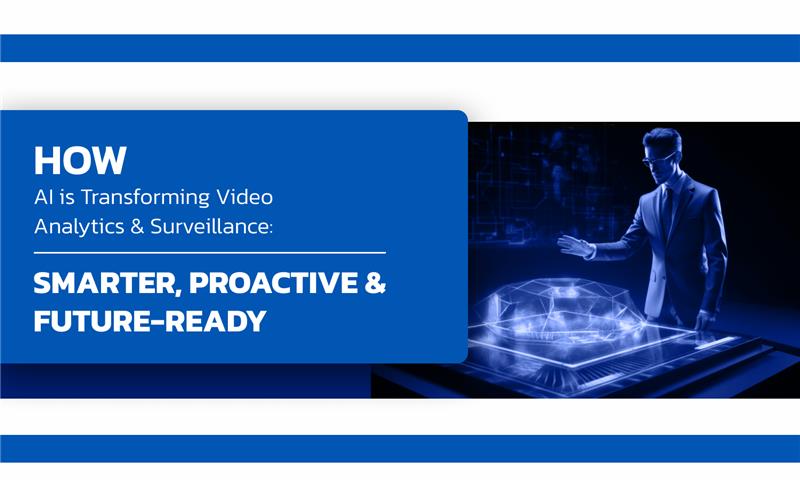How AI is Transforming Video Analytics & Surveillance: Smarter, Proactive & Future-Ready
AI has transformed many industries, and video surveillance is no exception. AI video analytics now enable smarter, faster, and more proactive monitoring compared to traditional systems. This evolution is powering a new era of security and operational efficiency across various sectors. From retail stores and industrial sites to gated communities and logistics hubs, AI based video analytics is redefining how video data is collected, analyzed, and acted upon.
This article explores how AI video analytics are revolutionizing surveillance by making it more intelligent and future-ready. It covers key benefits, real-world applications, and emerging trends in ai video analytics software. The rapid growth of smart surveillance systems shows how businesses and communities are embracing AI to enhance safety, reduce costs, and drive better decisions. Along the way, we’ll also highlight specific use cases such as retail video analytics and industrial video analytics, plus point to related AI Vision Solutions for holistic insights.
Table Of Contents
- Understanding AI Video Analytics in Surveillance
- Key Benefits of AI Video Analytics in Surveillance
- Applications of AI Video Analytics Software
- The Growing Role of AI-Powered Video Analytics
- Future Trends Shaping AI Video Analytics & Surveillance
- Challenges and Considerations
- Conclusion
Understanding AI Video Analytics in Surveillance
AI video analytics software goes far beyond simply recording footage for later review. These systems use machine learning algorithms and computer vision to detect, classify, and interpret objects and behaviors in real time. Whether it’s identifying an intruder, counting the number of customers entering a store, or monitoring an industrial production line, AI powered video analytics provide immediate actionable information instead of passive footage.
The core strength of AI video analytics lies in its ability to analyze video streams automatically and spot anomalies or predefined events. Smart surveillance systems integrate with existing video cameras and infrastructure, turning them into intelligent sensors. The software generates metadata such as time stamps, object types, movements, and suspicious actions that can be searched, analyzed, and acted upon instantly. This shift has made surveillance truly proactive rather than reactive.
Key Benefits of AI Video Analytics in Surveillance
1. Improved Accuracy and Reduced False Alarms
Traditional surveillance cameras that rely on simple motion detection often generate numerous false alarms. Everyday activities such as swaying trees, pets, or changing light conditions frequently trigger alerts, causing security teams to waste valuable time investigating non-threats. AI video analytics use advanced deep learning models that have been trained on millions of varied images and scenarios to distinguish between benign activities and genuine security incidents. For example, the AI can tell the difference between a falling leaf and a person attempting unauthorized entry.
2. Real-Time Threat Detection
One of the greatest advantages of AI video analytics is its ability to detect potential threats instantly. Unlike traditional systems that typically require human monitoring and manual review after an event occurs, AI-powered surveillance identifies suspicious behaviors or unauthorized activities as they happen. This could include recognizing loitering in a restricted area, detecting people climbing fences, or spotting objects left unattended. Once identified, alerts are sent immediately to the security team or automated responses are triggered, such as locking doors or activating alarms.
3. Scalability and Cost Savings
Smart surveillance systems powered by AI scale efficiently to monitor anywhere from a few to thousands of cameras without a linear increase in staff. This is critical for organizations with multiple sites or large campuses where manual monitoring would require prohibitively large security personnel teams. AI video analytics software continuously analyzes camera feeds around the clock, filtering data to highlight only relevant incidents for human attention.
4. Insightful Business Intelligence
Beyond improving safety, AI video analytics provide rich operational insights that drive better business decisions. For example, retail video analytics track customer movement patterns, dwell times, and queue lengths to help stores optimize layouts and staffing. These data-driven insights can improve customer experience, increase sales, and reduce waiting times. Industrial video analytics monitors manufacturing plants by detecting equipment malfunctions, monitoring safety compliance, and identifying inefficiencies.
5. Enhanced Privacy and Compliance
Privacy concerns are increasingly critical when implementing video surveillance solutions. AI-based video analytics software addresses these concerns by including features that anonymize or mask identifiable personal data before it is analyzed, helping organizations comply with strict data protection regulations. This ensures that surveillance enhances security and operational awareness without compromising individual privacy rights.
Applications of AI Video Analytics Software
1. Retail Video Analytics
Retailers are using AI video analytics to improve security and customer experience simultaneously. Tools like heatmapping track where customers spend most time, helping optimize store layouts. Queue management systems alert staff to long lines, reducing wait times. Shrinkage prevention models detect suspicious behavior such as shoplifting. These insights ultimately lead to increased sales and customer satisfaction.
2. Industrial Video Analytics
In manufacturing and industrial plants, AI video analytics improve safety and operational efficiency. The technology monitors production lines to detect malfunctioning equipment or unauthorized personnel entering hazardous zones. Real-time alerts prevent costly downtime and accidents. Video data combined with IoT sensor readings enables predictive maintenance and quality control.
3. Smart Surveillance Systems in Public and Private Spaces
From airports and campuses to gated communities, AI-powered video analytics create safer environments by detecting unusual behavior and tracking people or vehicles. Systems can automatically lock doors, dispatch security, or notify authorities when necessary. Integration with other smart city technologies enhances situational awareness and response.
The Growing Role of AI-Powered Video Analytics
AI algorithms continue to improve, enabling more complex analyses such as facial recognition, crowd counting, and behavioral detection. Smart logistics video analytics uses AI to monitor loading docks, track shipments, and prevent theft. Smart factories AI video analytics enhance process control and worker safety. Meanwhile, smart gated communities CCTV video analysis improves neighborhood security with automated visitor verification and anomaly detection.
The retail industry increasingly relies on retail AI video analytics software to transform everyday video feeds into useful business data. These insights guide staffing decisions, marketing campaigns, and operational adjustments. Harnessing AI in video analytics allows organizations to capitalize on their surveillance investments by unlocking both security and business value.
Future Trends Shaping AI Video Analytics & Surveillance
1. Edge AI and Real-Time Processing
Processing video data at the camera or local device known as edge computing ensures much faster analysis and greatly reduces network bandwidth use. This low-latency processing is critical for real-time threat detection, allowing smart surveillance systems to react and alert instantaneously when suspicious activity appears. For example, a smart camera using edge AI can immediately identify unauthorized access in a restricted zone and send an alert before an intruder gets far. Unlike cloud-reliant systems that may suffer delays due to data transfer, edge AI analyzes video locally, maintaining surveillance function even during network outages.
2. Cloud-Based Video Analytics Platforms
Cloud integration enables organizations to access video footage and analytic insights remotely from anywhere with an internet connection. This approach supports scalable surveillance solutions for businesses operating multiple sites or dispersed facilities. Rather than relying solely on local storage, cloud video analytics platforms centralize and aggregate data streams, making multi-location management seamless and efficient. Updates to AI models and analytics features happen automatically in the cloud, ensuring continuous improvement without manual intervention. Cloud platforms also offer robust data backup and disaster recovery options, safeguarding footage from loss or damage.
3. Integration with IoT and Smart Systems
AI video analytics increasingly function as part of broader security ecosystems integrated with IoT sensors, alarms, access control, and automation systems. When video analytics detect events—such as a suspicious person or safety violation—they can trigger automated responses like locking doors, activating sirens, or notifying emergency teams. This coordinated action improves response times and results in more adaptive, intelligent security networks.
4. Generative AI and Predictive Analytics
Next-generation AI video analytics employ generative AI and predictive analytics models that look beyond simple detection to anticipate potential risks and threats before they occur. By analyzing historical video records and real-time data streams, these advanced AIs identify patterns and anomalies signaling emerging dangers, such as crowd build-ups or repeated suspicious behaviors. Predictive analytics help security teams proactively deploy resources or initiate preventative measures, reducing incidents instead of merely reacting afterwards.
Challenges and Considerations
Despite the benefits, implementing AI video analytics software requires balancing privacy, cost, and accuracy. Organizations must ensure ethical use of facial recognition and data management practices to build trust. Selecting the right AI solution tailored to specific needs, whether retail, industrial, or community security, is critical for success.
1. Ethical Use and Privacy Protection
AI video analytics often involve sensitive data, including facial recognition and behavioral tracking. It is vital to implement these technologies ethically to avoid misuse or discrimination. Organizations should enforce strict data management policies, ensure transparency about video surveillance practices, and obtain necessary consents.
2. Accuracy and Model Adaptation
Achieving high detection accuracy in diverse, dynamic environments can be challenging. AI models trained on specific datasets may underperform as conditions change, a problem known as data drift. Regular model retraining and continuous calibration using updated or locally-relevant data are essential to maintain effective detection and reduce false alarms.
3. Cost and Infrastructure Requirements
Implementing AI video analytics involves investment in both hardware and software, plus potential upgrades to network and storage infrastructure. Organizations must evaluate the total cost of ownership including implementation, training, and ongoing maintenance. Cloud-based AI video analytics solutions may reduce upfront costs and ease scalability.
4. Integration and Compatibility
Many organizations operate heterogeneous security systems with legacy cameras, control rooms, and access controls. Ensuring that AI video analytics software integrates smoothly with existing infrastructure is critical for seamless operations. Middleware solutions or standardized APIs can bridge gaps between legacy and modern components.
Conclusion
AI video analytics is transforming surveillance from a passive, reactive tool into a smart, proactive, and future-ready system. Analyzing video in real time with advanced machine learning, AI based video analytics offer improved accuracy, faster threat detection, and valuable operational insights. Smart surveillance systems powered by AI enable businesses and communities to enhance security, optimize operations, and comply with privacy regulations more effectively.
From retail video analytics that boost customer satisfaction to industrial video analytics that improve safety and productivity, AI’s impact is broad and growing. Related solutions like AI Vision Solutions, retail store video analysis, smart logistics video analysis, smart factories video analysis, and smart gated communities video analysis demonstrate the range of innovation.
As technology advances with edge AI, cloud platforms, and predictive analytics, the future of video surveillance looks intelligent, integrated, and highly efficient. Businesses and communities adopting AI powered video analytics software today will be best prepared to meet evolving security challenges and leverage their video data for lasting value.



